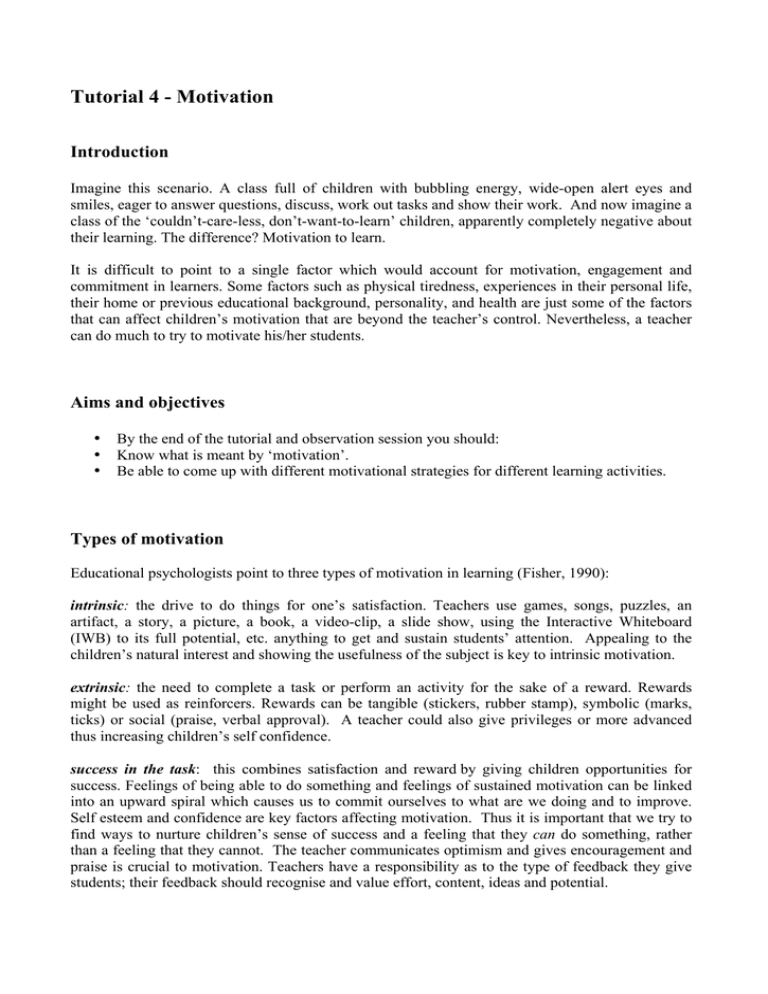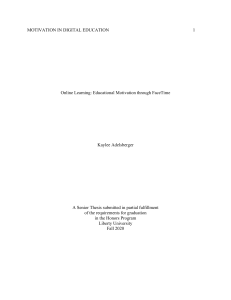Tutorial 4 - Motivation Introduction
advertisement

Tutorial 4 - Motivation Introduction Imagine this scenario. A class full of children with bubbling energy, wide-open alert eyes and smiles, eager to answer questions, discuss, work out tasks and show their work. And now imagine a class of the ‘couldn’t-care-less, don’t-want-to-learn’ children, apparently completely negative about their learning. The difference? Motivation to learn. It is difficult to point to a single factor which would account for motivation, engagement and commitment in learners. Some factors such as physical tiredness, experiences in their personal life, their home or previous educational background, personality, and health are just some of the factors that can affect children’s motivation that are beyond the teacher’s control. Nevertheless, a teacher can do much to try to motivate his/her students. Aims and objectives • • • By the end of the tutorial and observation session you should: Know what is meant by ‘motivation’. Be able to come up with different motivational strategies for different learning activities. Types of motivation Educational psychologists point to three types of motivation in learning (Fisher, 1990): intrinsic: the drive to do things for one’s satisfaction. Teachers use games, songs, puzzles, an artifact, a story, a picture, a book, a video-clip, a slide show, using the Interactive Whiteboard (IWB) to its full potential, etc. anything to get and sustain students’ attention. Appealing to the children’s natural interest and showing the usefulness of the subject is key to intrinsic motivation. extrinsic: the need to complete a task or perform an activity for the sake of a reward. Rewards might be used as reinforcers. Rewards can be tangible (stickers, rubber stamp), symbolic (marks, ticks) or social (praise, verbal approval). A teacher could also give privileges or more advanced thus increasing children’s self confidence. success in the task: this combines satisfaction and reward by giving children opportunities for success. Feelings of being able to do something and feelings of sustained motivation can be linked into an upward spiral which causes us to commit ourselves to what are we doing and to improve. Self esteem and confidence are key factors affecting motivation. Thus it is important that we try to find ways to nurture children’s sense of success and a feeling that they can do something, rather than a feeling that they cannot. The teacher communicates optimism and gives encouragement and praise is crucial to motivation. Teachers have a responsibility as to the type of feedback they give students; their feedback should recognise and value effort, content, ideas and potential. Issues to consider and discuss 1. What do you understand by motivation? 2. Why is motivation important in teaching? 3. What happens when the children are not motivated? 4. What motivational strategies can you think of? Observation tasks and activities 1. Is the classroom environment motivating? 2a. What kind of motivation does the teacher use? Intrinsic, extrinsic or success in the task? Give examples of each. 2b. How does the teacher sustain motivation? 2c. Observe the children’s reaction to a motivation strategy. 3. Does the teacher use rewards? What kind of rewards? Whom does he/she reward? 4. Observe one lesson and suggest possible motivational strategies that could have been used. 5a. Imagine you are going to plan and prepare an English reading lesson in the class you are observing. Choose a story from the class textbook. What would you use in the introduction of your lesson to capture the children’s attention? 5b. How would you sustain motivation throughout the lesson? 6. Make a list of motivational strategies one can use to motivate learners. Bibliography Fisher, R. (1990). Teaching children to think. Oxford: Basil Blackwell. Gilbert, I. (2012). Essential Motivation in the Classroom. London: Routledge. MacGrath, M. (2000). The Art of Peaceful Teaching in the Primary School: Improving Beahaviour and Preserving Motivation. London: David Fulton.











